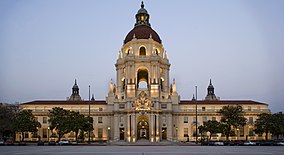
The Palace of Fine Arts is a monumental structure located in the Marina District of San Francisco, California, originally constructed for the 1915 Panama–Pacific International Exposition to exhibit works of art. Completely rebuilt from 1964 to 1974, it is the only structure from the exposition that survives on site.

San Francisco City Hall is the seat of government for the City and County of San Francisco, California. Re-opened in 1915 in its open space area in the city's Civic Center, it is a Beaux-Arts monument to the City Beautiful movement that epitomized the high-minded American Renaissance of the 1880s to 1917. The structure's dome is taller than that of the United States Capitol by 42 feet (13 m). The present building replaced an earlier City Hall that was destroyed during the 1906 earthquake, which was two blocks from the present one.
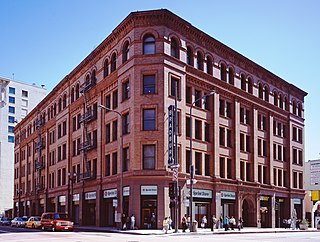
The Bradbury Building is an architectural landmark in downtown Los Angeles, California, United States. Built in 1893, the five-story office building is best known for its extraordinary skylit atrium of access walkways, stairs and elevators, and their ornate ironwork. The building was commissioned by Los Angeles gold-mining millionaire Lewis L. Bradbury and constructed by draftsman George Wyman from the original design by Sumner Hunt. It appears in numerous works of fiction and has been the site of many movie and television shoots and music videos.
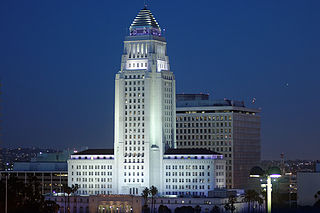
Los Angeles City Hall, completed in 1928, is the center of the government of the city of Los Angeles, California, and houses the mayor's office and the meeting chambers and offices of the Los Angeles City Council. It is located in the Civic Center district of downtown Los Angeles in the city block bounded by Main, Temple, First, and Spring streets, which was the heart of the city's central business district during the 1880s and 1890s.
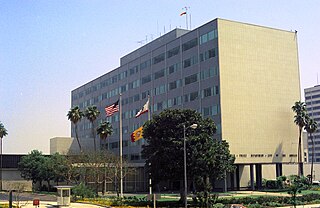
Parker Center, initially named the Police Administration Building or Police Facilities Building, was the former headquarters of the Los Angeles Police Department from 1955 until October 2009. It was located in Downtown Los Angeles at 150 North Los Angeles Street. Often nicknamed "The Glass House", the building was named for former LAPD chief William H. Parker in 1966.

The Utah State Capitol is the house of government for the U.S. state of Utah. The building houses the chambers and offices of the Utah State Legislature, the offices of the Governor, Lieutenant Governor, Attorney General, the State Auditor and their staffs. The capitol is the main building of the Utah State Capitol Complex, which is located on Capitol Hill, overlooking downtown Salt Lake City.
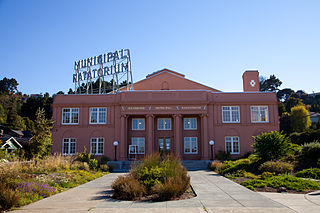
The Richmond Municipal Natatorium, commonly known as The Plunge or The Richmond Plunge, is a historic swim center in the Point Richmond neighborhood of Richmond, California. It was closed in August 2001 for seismic retrofitting and reopened in August 2010. It now is back to a regular schedule.

Architectural Resources Group is a firm that was founded in 1980 by Bruce Judd and Steve Farneth in San Francisco, CA. It began by providing professional services in the fields of architecture and urban planning with particular expertise in the area of historic preservation. In 2000, David Wessel, a Principal of ARG, founded a separate conservation-contracting division, ARG Conservation Services which operates under the same roof as ARG. By 2005, the firm had expanded to a full-service architecture firm with 50+ employees. ARG also opened offices in Pasadena serving Southern California, and Portland, Oregon, serving the Pacific Northwest.
Bruce D. Judd, FAIA, is a historic preservation architect based in Seaside, Florida, and San Francisco, California. He is a principal in the Bruce Judd Consulting Group in Seaside and a Consulting Founding Principal at the Architectural Resources Group in San Francisco. His projects have included surveying the historic African American community of Mound Bayou, Mississippi resulting in its being listed in the National Register of Historic Places. He has also consulted on the restoration of the Alamo Mission in San Antonio, Texas. Judd has directed more than 300 planning, rehabilitation, and expansion projects for architecturally significant buildings throughout the west and is a nationally recognized expert in his field. He has led rehabilitation and new construction projects for library, cultural, and performing arts facilities. He has also directed various high-profile projects including: master plan and restoration of the Hotel Del Coronado; repair and restoration of the San Francisco Conservatory of Flowers in Golden Gate Park, which received a National AIA Honor Award; master planning and seismic retrofit of the block-square Beaux-Arts style Pasadena City Hall which received LEED Gold certification; and rehabilitation of the historic Linde Robinson Laboratory for the Center for Global Environmental Ecology at Caltech in Pasadena, the first laboratory in a historic building to receive a LEED Platinum certification. Judd meets The Secretary of the Interior's Historic Preservation Professional Qualifications Standards in Architecture, Historic Architecture, Architectural History, and History.
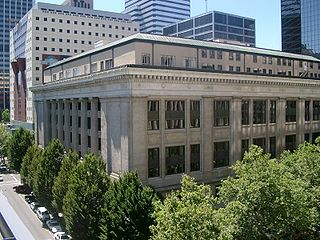
The Multnomah County Courthouse is a historic building that served as the courthouse for Multnomah County, Oregon from 1911 to 2020. It is located in downtown, Portland, Oregon, the county seat, and is listed on the National Register of Historic Places. Due to concerns over the structural deficiency of the then-century-old building, which was determined to need a costly seismic retrofit, the county board of commissioners decided in 2013 to launch plans to construct a new courthouse in a different location, to replace the existing building. Construction began in October 2016. The old courthouse closed on September 29, 2020, and the new courthouse opened on October 5. The old building was sold in 2018 to NBP Capital, which plans to convert it into a mixed-use development after making a seismic retrofit.

Seismic base isolation, also known as base isolation, or base isolation system, is one of the most popular means of protecting a structure against earthquake forces. It is a collection of structural elements which should substantially decouple a superstructure from its substructure that is in turn resting on the shaking ground, thus protecting a building or non-building structure's integrity.

Portland City Hall is the headquarters of city government of Portland, Oregon, United States. The four-story Italian Renaissance-style building houses the offices of the City Council, which consists of the mayor and four commissioners, and several other offices. City Hall is also home to the City Council chambers, located in the rotunda on the east side of the structure. Completed in 1895, the building was added to the National Register of Historic Places on November 21, 1974. City Hall has gone through several renovations, with the most recent overhaul gutting the interior to upgrade it to modern seismic and safety standards. The original was built for $600,000, while the 1996 to 1998 renovation cost $29 million.

The Pasadena Civic Center District is the civic center of and a historic district in Pasadena, California. The district is roughly bounded by Walnut and Green Streets and Raymond and Euclid Avenues.

Wadsworth Chapel, also known as the Catholic-Protestant Chapels, is actually two separate chapels under one roof on the campus of the Dept. of Veterans Affairs Medical Center in West Los Angeles, California. The structure was built in 1900 and was closed in 1971 after being damaged in the 1971 Sylmar earthquake. It is the oldest building on Wilshire Boulevard and was listed in the National Register of Historic Places in 1972. The structure has fallen into a state of disrepair due to the lack of funds within the Dept. of Veterans Affairs to pay for the required repairs and renovation.

The Highland Park Masonic Temple, also known as The Mason Building or The Highlands, is a historic three-story brick building on Figueroa Street in the Highland Park district of northeast Los Angeles, California.

Earthquake-resistant or aseismic structures are designed to protect buildings to some or greater extent from earthquakes. While no structure can be entirely impervious to earthquake damage, the goal of earthquake engineering is to erect structures that fare better during seismic activity than their conventional counterparts. According to building codes, earthquake-resistant structures are intended to withstand the largest earthquake of a certain probability that is likely to occur at their location. This means the loss of life should be minimized by preventing collapse of the buildings for rare earthquakes while the loss of the functionality should be limited for more frequent ones.
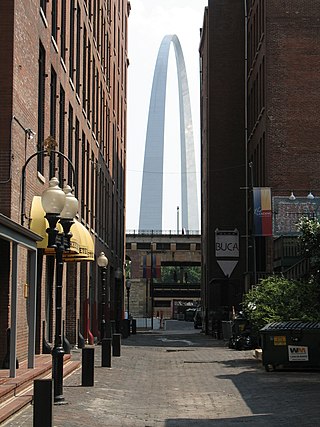
The architecture of St. Louis exhibits a variety of commercial, residential, and monumental architecture. St. Louis, Missouri is known for the Gateway Arch, the tallest monument constructed in the United States. Architectural influences reflected in the area include French Colonial, German, early American, European influenced, French Second Empire, Victorian, and modern architectural styles.

The 50 United Nations Plaza Federal Office Building is a United States federal building located on United Nations Plaza between Hyde and McAllister Streets in San Francisco, California. The 1936 Neoclassical style building, designed by Arthur Brown, Jr., is listed on the National Register of Historic Places, and is a contributing property to the San Francisco Civic Center Historic District, which is a National Historic Landmark.

Oakland City Hall is the seat of government for the city of Oakland, California. The current building was completed in 1914, and replaced a prior building that stood on what is now Frank H. Ogawa Plaza. Standing at the height of 320 feet (98 m), it was the first high-rise government building in the United States. At the time it was built, it was also the tallest building west of the Mississippi River. The City Hall is depicted on the city seal of Oakland.

The Audrey Geisel University House, historically known as the William Black House, is the private residence of the Chancellor of the University of California San Diego. Located in La Jolla, California, it is a historic site that is listed on the National Register of Historic Places. It is located at 9630 La Jolla Farms Road and overlooks Black's Beach, the Scripps Coastal Reserve, and the Pacific Ocean.
